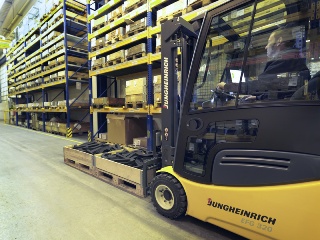 Jungheinrich's RFID solution |
Jungheinrich UK has launched two new automated pallet scanning and identification solutions that "turn forklifts into logistics units".
Steve Richmond, general manager of Jungheinrich UK Ltd's systems and projects division, says Jungheinrich feels the solutions developed turn forklifts into the communication centre for processing material and information between the warehouse management system and the warehouse floor.
"By integrating the forklift into the information process, we can increase efficiency and safety, reduce costs and energy consumption, and improve on ergonomics for the operator."
Richmond says the new systems optimise the forklift's on-board intelligence systems and integrate them into the supply chain information process. "We believe that our new automatic scanning systems represent a significant step forward in forklift intelligence."
The new pallet scanning system fits a scanning device to the back of the fork assembly and automatically records the ID barcode on the pallet load.
After scanning the barcode, the scanner automatically switches off for safety reasons. The information on the barcode is relayed to the warehouse management system (WMS) and a pallet location is allocated within the racking.
The forklift delivers the load to the specified destination and the pallet location ID is scanned to confirm it is in the proper place. Once the WMS has confirmed the pallet's correct location, the forklift operator receives the next set of instructions via the on-board terminal.
The new scanning system is compatible with most leading WMS brands and all Jungheinrich models.
Richmond says traditional pallet scanning methods take time and can be difficult - particularly when the operator is trying to scan through the mast.
"There are also ergonomic implications if the driver is forced to twist and turn in order to get a good 'shot' at the barcode with the terminal. Our new systems remove these issues."
Jungheinrich has also devised a similar fork-based system that uses RFID technology and scanning antennae integrated within the forks to automatically scan several pallets at the same time.
All pallets are fitted with their own built-in RFID transponder that contains the pallet ID. The antennae within the forks read the pallet's ID and relay the information to the WMS.
Richmond says the ability to identify multiple pallets at the same time using RFID technology in a single scanning step is a significant benefit. "It saves time compared to manual scanning and improves the ergonomics for the driver. It also improves process safety and operational efficiency by reducing put-away errors."
"At the moment, this new system is at its most productive in closed pallet systems, but RFID will become more and more widely used for pallet identification purposes," he adds. "We believe it is only a matter of time before this technology is more widely adopted."